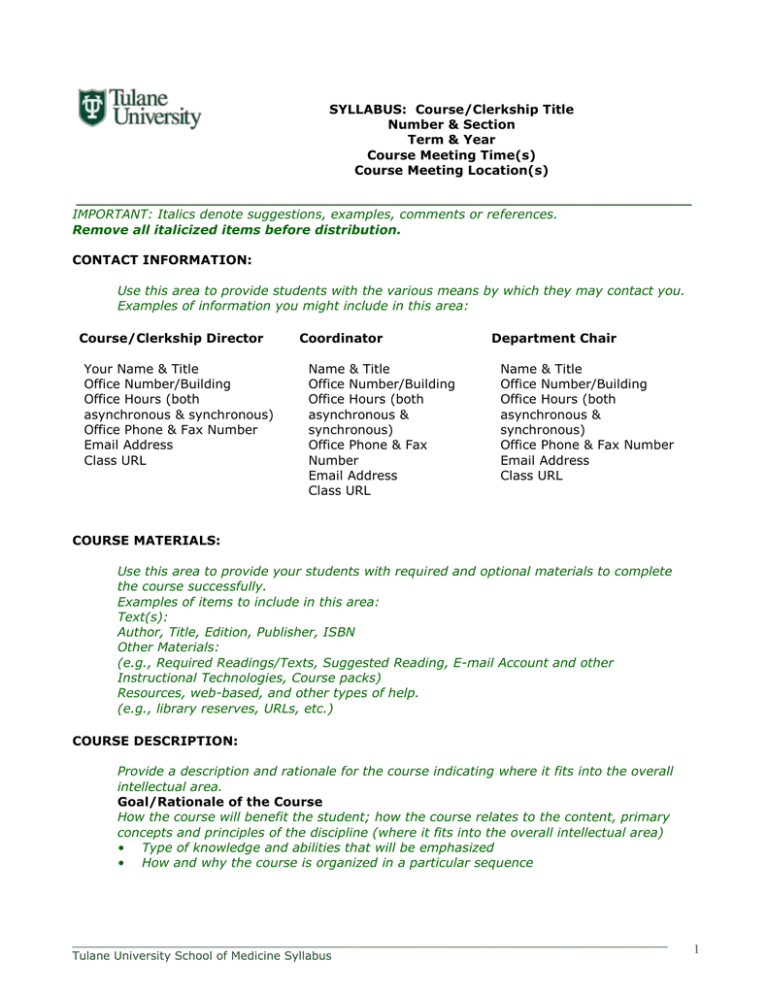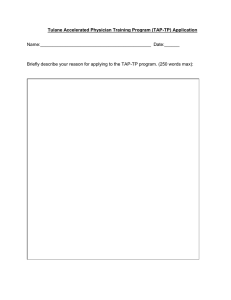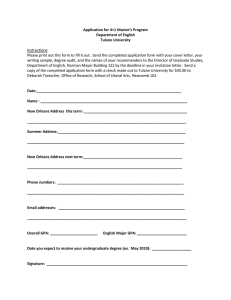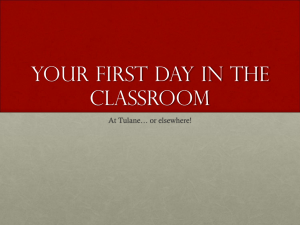Document 17535788
advertisement

SYLLABUS: Course/Clerkship Title Number & Section Term & Year Course Meeting Time(s) Course Meeting Location(s) _____________________________________________________________________ IMPORTANT: Italics denote suggestions, examples, comments or references. Remove all italicized items before distribution. CONTACT INFORMATION: Use this area to provide students with the various means by which they may contact you. Examples of information you might include in this area: Course/Clerkship Director Your Name & Title Office Number/Building Office Hours (both asynchronous & synchronous) Office Phone & Fax Number Email Address Class URL Coordinator Name & Title Office Number/Building Office Hours (both asynchronous & synchronous) Office Phone & Fax Number Email Address Class URL Department Chair Name & Title Office Number/Building Office Hours (both asynchronous & synchronous) Office Phone & Fax Number Email Address Class URL COURSE MATERIALS: Use this area to provide your students with required and optional materials to complete the course successfully. Examples of items to include in this area: Text(s): Author, Title, Edition, Publisher, ISBN Other Materials: (e.g., Required Readings/Texts, Suggested Reading, E-mail Account and other Instructional Technologies, Course packs) Resources, web-based, and other types of help. (e.g., library reserves, URLs, etc.) COURSE DESCRIPTION: Provide a description and rationale for the course indicating where it fits into the overall intellectual area. Goal/Rationale of the Course How the course will benefit the student; how the course relates to the content, primary concepts and principles of the discipline (where it fits into the overall intellectual area) • Type of knowledge and abilities that will be emphasized • How and why the course is organized in a particular sequence ___________________________________________________________________________________ Tulane University School of Medicine Syllabus 1 COURSE OBJECTIVES: Learning Objectives [written objectives of each course and course outlines to students. University policy requires that an outline of the course contents are distributed at the beginning of the semester along with the written objectives. The evaluation of each instructor’s teaching effectiveness will begin with the written objectives of the instructor’s course.] These objectives must be aligned with the institutional goals/learning objectives. • What the students will gain from your course • Why you chose these objectives as the most important skills/knowledge (It is helpful to include objectives for each of the class meetings or topics) List course/clerkship learning objectives: (please add rows as needed) 1. 2. 3. TEACHING PHILOSOPHY: What is your approach for teaching this course? What do you think students should do to best benefit from the course? You may include your expected teaching methods and a statement regarding students’ responsibility for expected teaching methods and a statement regarding students’ responsibility for learning and your responsibilities as their instructor. COURSE POLICIES: Use this area to provide the student with your class policies (e.g., policies dealing with attendance, final exams, missed tests, late papers, make-up classes). Essential Policy Information (Accompanying each item should be a statement on how each will impact grades.) Attendance /Lateness Policy Policy for Late Work Policy for Missed Tests Policy for Extra Credit Copy Statement [Suggested language]: Some of the materials in this course are possibly copyrighted. They are intended for use only by students registered and enrolled in this course and only for instructional activities associated with and for the duration of the course. They may not be retained in another medium or disseminated further. They are provided in compliance with the provisions of the Teach Act (Section 110(1) of the Copyright Act) http://www.copyright.gov/docs/regstat031301.html. GRADING/EVALUATION: Use this area to provide grading standards for the course. Evaluation (Grading) Standards and Methods – A clear explanation of evaluation, including a clear statement on the assessment process and measurements. Be explicit! You may include format, number, weight for quizzes and exams, descriptions of papers and projects, as well as how they will be assessed and the overall grading scale and standards. ___________________________________________________________________________________ Tulane University School of Medicine Syllabus 2 ASSIGNMENTS/RESPONSIBILITIES: This area should detail specific course assignments (e.g., exams, papers, and special projects). COURSE CONTENT AND OUTLINE: University policy requires that an outline of the course content be distributed at the beginning of the semester along with the written objectives. The outline could be presented in a variety of formats (e.g., by topic, lecture, unit, date, calendar, Holiday/Other Non-Meeting Dates, Due Dates for Reading, Assignments, Tests, Projects etc). (please add rows as needed) Date Topics and Activities Readings (due on this date) Assignments (due on this date) RESOURCES: Use this area to add information for additional resources: Web-based resources Labs Study Groups/Halls Other Types of Help TULANE SCHOOL OF MEDICINE HONOR POLICY: The Office Student Affairs suggests: The Tulane University School of Medicine Honor Policy outlines the School of Medicine expectations for the integrity of students’ academic work, the procedures for resolving alleged violations of those expectations, and the rights and responsibilities of students and faculty members throughout the process. Students are responsible for reading the Honor Policy and for living up to their pledge not to violate the Honor Code. I. II. III. IV. V. VI. VII. It shall be a violation of this Honor Code for a student to cheat. It shall be a violation of this Honor Code for a student to knowingly circumvent any course requirement. It shall be a violation of this Honor Code for a student to steal. It shall be a violation of this Honor Code for a student to purposely impair another student's educational opportunity. It shall be a violation to act in a manner which is detrimental to the moral and ethical standards of the medical profession. It shall be a violation for a student to knowingly deceive another student, faculty member, or professional associate with the intent to gain advantage, academic or otherwise, for said student or for any other student. It shall be a violation for any student to fail to report any infraction of the Honor System to an appropriate representative. Tulane University School of Medicine Honor Policy can be found at: http://www.som.tulane.edu/student/honorcode/new.htm ___________________________________________________________________________________ Tulane University School of Medicine Syllabus 3 AMERICANS WITH DISABILITIES ACT: The SOM OFFICE OF STUDENT AFFAIRS suggests: Students with disabilities needing academic accommodation should: (1) register with and provide documentation to the Student Disability Resource Center; (2) bring a letter to the instructor indicating the need for accommodation and what type. This should be done during the first week of class. This syllabus and other class materials are available in alternative format upon request. http://erc.tulane.edu/AccomDefs.html For more information about services available to TUSOM student with disabilities, contact: The Goldman Office of Disability Services Center for Educational Resources and Counseling 1st floor Mechanical Engineering Building Tulane University New Orleans, LA 70118-5698 (504) 862-8433 (504) 862-8435 SOM INSTITUTIONAL LEARNING GOALS/OBJECTIVES: From the list below, select the goals/objectives that apply to your course/clerkship in the following learning domains. Please delete those that do not apply to your course/clerkship and is not listed with your course/clerkship objectives above. This can easily be done by placing the number of the learning objective that applies to the Institutional goals/objectives and listing how you plan to assess students' K,AB,Ss by filling in the assessment method column (see CurrMIT checklist). http://tulane.edu/som/ome/upload/Tulane_SOM_Learning_Objectives_Phase_1_-_2.pdf Knowledge (K=KNOWLEDGE) Aligned with Course Learning Objective Assessment Method Aligned with Course Learning Objective Assessment Method K1: basic scientific principles of cellular and molecular medicine K2: normal structure, function and pathophysiology of all organ systems K3: scientific basis of modern therapeutics K4: all components of the medical interview and physical examination K5: fundamental issues of environmental health K6: principles and application of scientific literature K7: foundations of evidence-based medicine K8: use of modern information technology K9: basic principles and practice of medical ethics K10: usefulness of community resources K11: apply the basic science principles of normal and abnormal structure and function to clinical medicine K12: apply the principles of clinical reasoning K13: recognize and manage common medical problems K14: recognize and respond to acute life-threatening problems K15: provide patient care based on the human life cycle stages K16: apply the principles of evidence-based medicine K17: develop the clinical competencies expected in each of the core medical specialties K18: describe the organization and systems of health care delivery and financing K19: apply principles of preventive and population-based medicine including environmental health issues K20: provide patient care with regard for psychosocial issues K21: apply the principles of clinical epidemiology, medical ethics, and alternative medicine in clinical medicine Attitude/Behavioral (AB=ATTITUDES/BEHAVIORS) AB1: act with integrity, honesty and candor AB2: treat the patient as a person ___________________________________________________________________________________ Tulane University School of Medicine Syllabus 4 AB3: view medicine as a service profession AB4: maintain confidentiality about patients, colleagues, faculty, etc. AB5: practice humanism, courtesy, and social decorum AB6: exhibit teamwork and collegiality AB7: respect diversity AB8: promote equity AB9: work through ambiguity and uncertainty AB10: altruism, honesty, ethical behavior, caring and compassion AB11: use of adaptive mechanisms for dealing with stress AB12: commitment to excellence in patient care AB13: commitment to the patient's welfare and advocacy AB14: respect for and cooperation with all participants of the health care system AB15: sensitivity to diversity AB16: appreciation of medicine as a service profession AB17: commitment to equity AB18: responsibility for preventive care AB19: participation in providing public health education AB20: engagement in life-long learning and adaptability to the changing health care environment AB21: commitment to civic responsibilities Skills (S=SKILLS) Aligned with Course Learning Objective Assessment Method S1: apply basic knowledge in a clinical setting S2: establish rapport with patients S3: perform a reliable history and physical exam S4: generate a basic "problem list" based on the history and physical exam S5: communicate effectively in oral and written form S6: work collaboratively in problem-solving S7: navigate biomedical information resources S8: use critical thinking S9: apply BLS training S10: use effective learning techniques S11: use learning resources, including mentors, effectively S12: evaluate and remedy personal deficiencies S13: develop effective test-taking skills S14: manage time effectively S15: balance personal and professional life S16: perform a comprehensive or focused history and physical examination, and recognize the appropriateness of when to perform each of these exams. S17: order and interpret appropriate laboratory and diagnostic studies S18: integrate history, physical examination and laboratory results S19: perform routine and simple procedures necessary for patient care S20: tailor treatment to individual patients S21: recognize normal and abnormal findings across the life cycle S22: generate appropriate differential and working diagnoses S23: use information and knowledge seeking skills necessary for life-long learning S24: cope with ambiguity and uncertainty S25: recognize and differentiate between emergent, urgent, and routine health conditions S26: coordinate or arrange appropriate intervention S27: interact in a confidence-inspiring manner with patients and their families S28: provide informed consent S29: recognize and manage personal limitations in treating patients, evaluate and remediate personal deficiencies S30: listen to and communicate information effectively to patients, families, and colleagues S31: exercise conflict resolution S32: work effectively with others on the healthcare team S33: advocate for community needs S34: apply population knowledge to patient management ___________________________________________________________________________________ Tulane University School of Medicine Syllabus 5 SOM INSTITUTIONAL COMPETENCIES: From the list below, select the competencies that apply to your course/clerkship in the following outcome areas. Please delete those that do not apply to your course/clerkship. This can easily be done by placing the number of the learning objective that applies to the competency and listing how you plan to assess the outcome of the competency, by filling in the assessment method (see CurrMIT checklist). PC=Patient Care Aligned with Course Learning Objectives Assessment Method PC1: Communicate effectively and demonstrate caring and respectful behaviors when interacting with patients and their families. PC2: Gather essential and accurate information about their patients. PC3: Make informed decisions about diagnostic and therapeutic interventions based on patient information and preferences, up-to-date scientific evidence, and clinical judgment. PC4: Develop and carry out patient management plans. PC5: Counsel and educate patients and their families. PC6: Use information technology to support patient care decisions and patient education. PC7: Perform competently all medical and invasive procedures considered essential for the area of practice. PC8: Provide health care services aimed at preventing health problems or maintaining health. PC9: Work with health care professionals, including those from other disciplines, to provide patient-focused care. MK=Medical Knowledge MK1: Demonstrate an investigatory and analytic thinking approach to clinical situations. MK2: Know and apply the basic and clinically supportive sciences, which are appropriate to their discipline. PBL=Practice-based Learning and Improvement PBL1: Practice-based Learning and Improvement: Analyze practice experience and perform practice-based improvement activities using a systematic methodology. PBL2: Practice-based Learning and Improvement: Locate, appraise, and assimilate evidence from scientific studies related to their patients’ health problems. PBL3: Practice-based Learning and Improvement: Obtain and use information about their own population of patients and the larger population from which their patients are drawn. PBL4: Practice-based Learning and Improvement: Apply knowledge of study designs and statistical methods to the appraisal of clinical studies and other information on diagnostic and therapeutic effectiveness. PBL5: Practice-based Learning and Improvement: Use information technology to manage information, access on-line medical information; and support their own education. PBL6: Practice-based Learning and Improvement: Facilitate the learning of students and other health care professionals. ICS=Interpersonal and Communication Skills ICS1: Create and sustain a therapeutic and ethically sound relationship with patients. ICS2: Use effective listening skills and elicit and provide information using effective nonverbal, explanatory, questioning, and writing skills. ICS3: Work effectively with others as a member or leader of a health care team or other professional group. P=Professionalism ___________________________________________________________________________________ Tulane University School of Medicine Syllabus 6 P1: Professionalism: Demonstrate respect, compassion, and integrity; a responsiveness to the needs of patients and society that supercedes selfinterest; accountability to patients, society, and the profession; and a commitment to excellence and on-going professional development. P2: Professionalism: Demonstrate a commitment to ethical principles pertaining to provision or withholding of clinical care, confidentiality of patient information, informed consent, and business practices. P3: Professionalism: Demonstrate sensitivity and responsiveness to patients’ culture, age, gender, and disabilities. SBP=Systems-based Practice SBP1: Systems-based Practice: Understand how their patient care and other professional practices affect other health care professionals, the health care organization, and the larger society and how these elements of the system affect their own practice. SBP2: Systems-based Practice: Know how types of medical practice and delivery systems differ from one another, including methods of controlling health care costs and allocating resources. SBP3: Systems-based Practice: Practice cost-effective health care and resource allocation that does not compromise quality of care. SBP4: Systems-based Practice: Advocate for quality patient care and assist patients in dealing with system complexities. SBP5: Systems-based Practice: Know how to partner with health care managers and health care providers to assess, coordinate, and improve health care and know how these activities can affect system performance. SYLLABUS CHANGE POLICY: Suggestion: Except for changes that substantially affect implementation of the evaluation (grading) statement, this syllabus is a guide for the course and is subject to change with advanced notice. NOTE: Remember to delete all italicized instructions before sending your completed syllabus to the Office of Medical Education. Thank you! ___________________________________________________________________________________ Tulane University School of Medicine Syllabus 7


